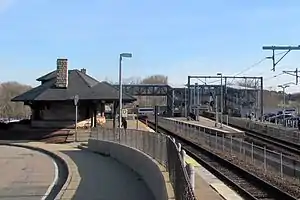Canton Junction station
Canton Junction is an MBTA Commuter Rail station in Canton, Massachusetts. It serves the Providence/Stoughton Line, and is planned for future service on the South Coast Rail line. It is located slightly north of the Canton Viaduct and west of downtown Canton.
Canton Junction | ||||||||||||||||||
|---|---|---|---|---|---|---|---|---|---|---|---|---|---|---|---|---|---|---|
 Canton Junction station in April 2016 | ||||||||||||||||||
| Location | Beaumont Street at Sherman Street Canton, Massachusetts | |||||||||||||||||
| Coordinates | 42°09′46″N 71°09′13″W | |||||||||||||||||
| Owned by | Massachusetts Bay Transportation Authority | |||||||||||||||||
| Line(s) | Northeast Corridor Stoughton Branch | |||||||||||||||||
| Platforms | 2 side platforms 1 island platform | |||||||||||||||||
| Tracks | 2 (Northeast Corridor) 2 (Stoughton Branch) | |||||||||||||||||
| Construction | ||||||||||||||||||
| Parking | 764 spaces ($4.00 fee) 11 accessible spaces | |||||||||||||||||
| Disabled access | Yes | |||||||||||||||||
| Other information | ||||||||||||||||||
| Fare zone | 3 | |||||||||||||||||
| History | ||||||||||||||||||
| Rebuilt | 1892 | |||||||||||||||||
| Previous names | Canton | |||||||||||||||||
| Passengers | ||||||||||||||||||
| 2018 | 1,115 (weekday average boardings)[1] | |||||||||||||||||
| Services | ||||||||||||||||||
| ||||||||||||||||||
| ||||||||||||||||||
At Canton Junction, the Stoughton Branch of the Providence/Stoughton Line splits from the Northeast Corridor and runs southeast to Stoughton, Massachusetts. The Providence section of the line follows the Northeast Corridor south to Providence, Rhode Island and beyond.
History

Canton Junction opened with the Boston and Providence Railroad in 1835; the Stoughton Branch Railroad opened in early 1845. The current station building was designed by Bradford Lee Gilbert in the Richardsonian Romanesque style and built by the Old Colony Railroad in 1892. It became part of the New York, New Haven and Hartford Railroad a year later in 1893.[2]
By the early 1990s, Boston–Foxboro trains for events at Foxborough Stadium operated over the Providence/Stoughton Line, with intermediate stops including Canton Junction.[3] When Providence–Foxboro event service resumed in 1994, Boston–Foxboro service was rerouted over the Franklin Line.[4][5][6]
The massive footbridge, built around 2000, showed significant rust and damage to concrete by 2015.[7] Keolis (the commuter rail contract operator) begin major repairs on the footbridge in 2016; however, the company failed to obtain the proper building permits. Construction was suspended in March 2017 with the western ramp and stairs still closed; passengers had to detour on foot over the Spaulding Street bridge to access the Providence-bound platform and the Jackson Street parking lot.[8][9] Construction resumed in July 2017 and was completed in August.[10]
References
- Central Transportation Planning Staff (2019). "2018 Commuter Rail Counts". Massachusetts Bay Transportation Authority.
- Existing Railroad Stations in Norfolk County, Massachusetts
- "MBTA rail service is available to Patriots games". Boston Globe. September 12, 1993. p. 39 – via Newspapers.com.

- Belcher, Jonathan. "Changes to Transit Service in the MBTA district" (PDF). NETransit.
- Hernandez, Efrain (June 17, 1994). "How to get to the game". Boston Globe. p. 108 – via Newspapers.com.

- Smith, Sean (September 14, 1997). "If you're going to the game..." Boston Globe. p. 64 – via Newspapers.com.

- Turner, Jay (August 7, 2015). "Frustrations mount over conditions at Canton Junction". Canton Citizen. Retrieved March 25, 2017.
- "Commuter Rail Service Alerts: Providence/Stoughton Line". Massachusetts Bay Transportation Authority. March 18, 2017. Archived from the original on March 25, 2017.
- "Canton Junction Ramp". Town of Canton. June 10, 2017. Archived from the original on June 19, 2017. Retrieved June 10, 2017.
- "Commuter Rail Service Alerts: Providence/Stoughton Line". Massachusetts Bay Transportation Authority. July 20, 2017. Archived from the original on July 22, 2017.
Further reading
- Galvin, Edward D. (1987). A History of Canton Junction. Brunswick, Maine: Distributed by Sculpin Publications. OCLC 17939563.CS1 maint: ref=harv (link)